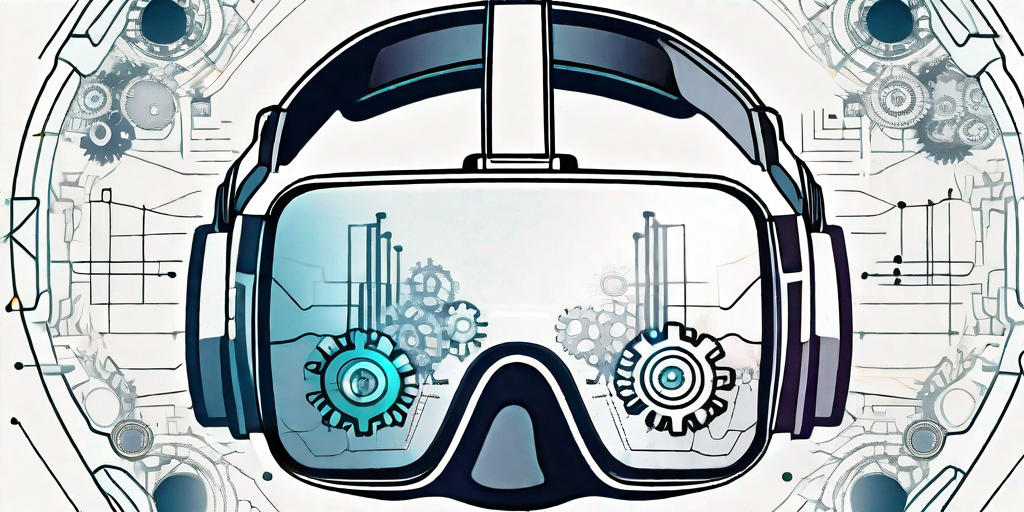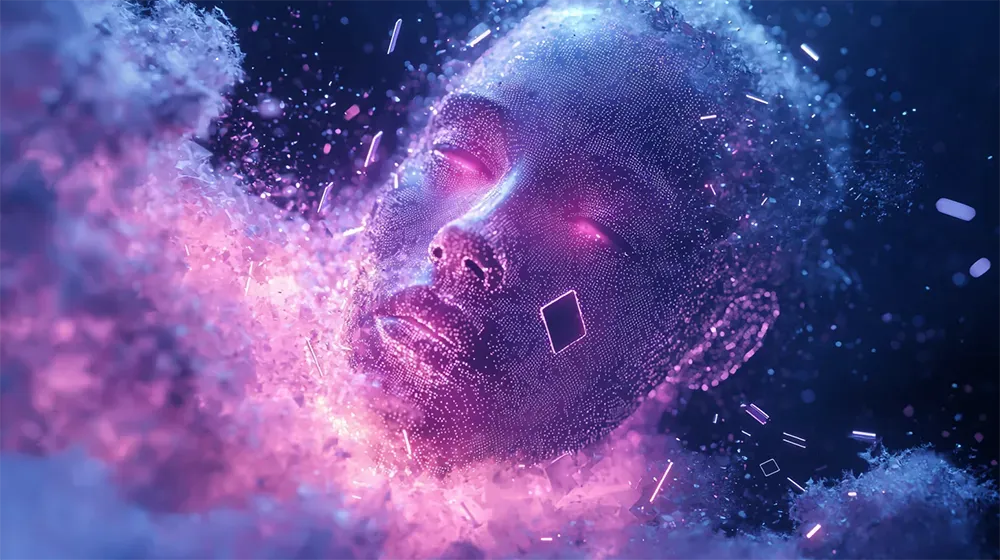An Innovation Futurist's Guide to Understanding Virtual Reality

An Innovation Futurist's Guide to Understanding Virtual Reality
Virtual reality (VR) has rapidly emerged as one of the most transformative technologies of our time. With its ability to transport users to realistic digital environments, VR has opened doors to limitless possibilities in various industries. As an innovation futurist, it's crucial to gain a comprehensive understanding of this technology and its impact on the future. In this guide, we will explore the realm of virtual reality, discuss the role of an innovation futurist in understanding VR technology, delve into the impact of VR on different industries, and examine how an innovation futurist predicts the future of VR. Finally, we will explore practical applications of VR in everyday life.
Exploring the Realm of Virtual Reality
Before we dive deeper, let's develop a fundamental understanding of virtual reality. VR is an immersive technology that simulates a three-dimensional environment, allowing users to interact with and explore virtual worlds. By wearing a VR headset, users are transported to alternate realities, experiencing sights, sounds, and even tactile sensations that mimic real-life experiences.
Virtual reality has come a long way since its inception, and thanks to advancements in hardware and software, the technology has become more accessible than ever before. From gaming and entertainment to education and healthcare, virtual reality is revolutionizing the way we experience and interact with our digital world.
One of the most exciting aspects of virtual reality is its potential in the gaming industry. With VR, gamers can now step into the shoes of their favorite characters, immersing themselves in rich and detailed virtual worlds. Whether it's exploring fantastical realms, battling enemies in intense combat, or solving intricate puzzles, virtual reality gaming takes the gaming experience to a whole new level.
But virtual reality is not just limited to gaming and entertainment. It has also found its way into the field of education. Imagine being able to take a virtual field trip to ancient civilizations, walking through the ruins of ancient Rome or exploring the depths of the ocean without leaving the classroom. Virtual reality has the power to transport students to places they could only dream of visiting, making learning more engaging and interactive.
Furthermore, virtual reality has shown great potential in the healthcare industry. It is being used to train medical professionals in realistic simulated environments, allowing them to practice complex procedures without the risk of harming real patients. Virtual reality can also be used as a therapeutic tool, helping patients overcome phobias, manage pain, and even treat mental health conditions.
As virtual reality continues to evolve, we can expect to see even more innovative applications in various fields. From architecture and design to tourism and marketing, the possibilities are endless. Virtual reality has the power to transform industries and create new opportunities for businesses and individuals alike.
The Role of an Innovation Futurist in Understanding VR Technology
As an innovation futurist, it is your responsibility to stay ahead of technological advancements and anticipate their impact on society. Understanding virtual reality is essential for you to provide valuable insights and predictions. By studying the evolving capabilities of VR, you can identify potential applications, analyze market trends, and guide organizations towards embracing this transformative technology.
Virtual reality (VR) has come a long way since its inception. Initially, it was primarily associated with gaming and entertainment, but its potential has expanded far beyond that. As an innovation futurist, you must delve into the various industries where VR is making a significant impact. For example, in the field of healthcare, VR is being used for medical training, pain management, and even therapy for mental health conditions. By understanding these applications, you can help organizations in the healthcare sector leverage VR to improve patient care and outcomes.
Furthermore, your role extends beyond understanding the technical aspects of VR. It involves exploring the human experience within virtual environments, considering factors such as user behavior, ethics, and the potential implications of widespread adoption. By taking a holistic approach, you can offer a well-rounded perspective that goes beyond the technology itself.
When it comes to user behavior, studying how individuals interact with VR can provide valuable insights. For instance, understanding how users navigate virtual spaces, their reactions to different stimuli, and the level of immersion they experience can help shape the design and development of VR experiences. By analyzing user behavior, you can assist organizations in creating more engaging and intuitive virtual environments.
Ethics also play a crucial role in the adoption of VR technology. As an innovation futurist, you must consider the ethical implications of using VR in various contexts. For example, in the field of education, VR can provide immersive learning experiences, but it also raises questions about privacy, data security, and the potential for addiction. By addressing these ethical concerns, you can guide organizations towards responsible and ethical use of VR.
Moreover, the widespread adoption of VR has the potential to reshape various industries and societal norms. It can revolutionize the way we work, communicate, and even socialize. As an innovation futurist, you must analyze the potential implications of VR's widespread use and help organizations navigate the changes it brings. By understanding the broader societal impact, you can assist businesses in adapting their strategies and operations to thrive in a VR-driven future.
In conclusion, as an innovation futurist, understanding VR technology goes beyond just grasping its technical aspects. It involves exploring its applications across different industries, analyzing user behavior, addressing ethical concerns, and considering the broader societal impact. By gaining a comprehensive understanding of VR, you can provide valuable insights and guidance to organizations, enabling them to embrace this transformative technology and stay ahead in an ever-evolving digital landscape.
Impact of Virtual Reality on Various Industries
Virtual reality has the power to redefine industries in ways we never thought possible. Let's take a closer look at some key sectors and how VR is poised to make a significant impact:
- Gaming and Entertainment: VR has already made waves in the gaming industry, providing players with unparalleled immersion and interactivity. Expect even more innovative gaming experiences as developers push the boundaries of virtual reality.
- Education and Training: Virtual reality offers immersive educational experiences, allowing students to explore historical events, conduct scientific experiments, and practice real-life scenarios in a safe and controlled environment.
- Healthcare and Medicine: VR has the potential to revolutionize healthcare by enabling medical professionals to visualize complex data, perform simulations, and even conduct remote surgeries, ultimately improving patient care and outcomes.
- Architecture and Design: Virtual reality is transforming the way architects and designers conceptualize and present their ideas. Clients can now experience virtual walkthroughs of buildings and spaces before they are even constructed.
These are just a few examples of how virtual reality is reshaping industries, but the possibilities are endless. As an innovation futurist, it will be essential for you to monitor these developments and identify emerging opportunities for organizations to leverage VR to their advantage.
Furthermore, the impact of virtual reality extends beyond the sectors mentioned above. Let's explore a few more industries where VR is making its mark:
Automotive: Virtual reality is revolutionizing the automotive industry by enhancing the design and testing processes. Car manufacturers can now create virtual prototypes, allowing them to identify design flaws and make necessary adjustments before physical production begins. Additionally, VR is being used to train automotive technicians, providing them with a realistic and immersive learning experience.
Tourism and Hospitality: Virtual reality is transforming the way people plan and experience their vacations. Travel agencies and hotels are utilizing VR to provide virtual tours of destinations and accommodations, giving potential customers a realistic preview of what they can expect. This technology is also being used to create virtual travel experiences, allowing individuals to explore famous landmarks and attractions without leaving their homes.
Retail: Virtual reality is changing the way consumers shop. Retailers are leveraging VR to create virtual stores, enabling customers to browse and purchase products from the comfort of their own homes. This technology also allows shoppers to try on clothes virtually, eliminating the need for physical fitting rooms and enhancing the overall shopping experience.
Sports: Virtual reality is revolutionizing the sports industry by providing fans with immersive viewing experiences. VR technology allows viewers to feel like they are in the stadium, watching the game from different angles and perspectives. This enhances fan engagement and opens up new revenue streams for sports organizations.
Real Estate: Virtual reality is transforming the way properties are bought and sold. Potential buyers can now take virtual tours of homes and properties, allowing them to explore every corner and visualize themselves living in the space. This technology saves time and resources for both buyers and sellers, making the real estate process more efficient.
As you can see, virtual reality is making a significant impact across various industries. Its ability to provide immersive and interactive experiences is reshaping the way we work, learn, and entertain ourselves. The potential for innovation and growth in the VR space is vast, and staying informed about these developments will be crucial for organizations and individuals looking to stay ahead in this rapidly evolving landscape.
How an Innovation Futurist Predicts the Future of VR
Predicting the future of any technology, especially one as fast-evolving as virtual reality, requires a deep understanding of current trends, market dynamics, and user behavior. As an innovation futurist, you must embrace a data-driven approach, combining market research, expert insights, and your own intuition to make informed predictions.
One crucial aspect is to closely monitor advancements in VR hardware and software. Analyzing the capabilities and limitations of existing technologies can help identify areas for improvement and anticipate breakthrough developments. Additionally, staying informed about consumer adoption rates and industry investments can provide valuable indicators of the technology's trajectory.
While predicting the future can never be an exact science, the role of an innovation futurist is to guide organizations in making informed decisions and capitalizing on the potential benefits of virtual reality.
Practical Applications of Virtual Reality in Everyday Life
While virtual reality holds incredible potential on a grand scale, it is equally important to recognize its practical applications in our day-to-day lives. Here are some examples of how VR can enhance our everyday experiences:
- Travel and Tourism: Imagine exploring famous landmarks, remote destinations, or even tourist attractions from the comfort of your home, all through immersive virtual reality experiences.
- Social Interactions: VR can bridge geographical barriers, enabling individuals to connect with friends, family, or colleagues in virtual spaces, making distance feel irrelevant.
- Therapy and Mental Wellbeing: Virtual reality therapy is gaining traction as a powerful tool in treating various mental health conditions such as phobias, PTSD, and anxiety disorders.
As virtual reality technology continues to evolve, we can expect even more practical applications that enhance our daily lives, blurring the line between the physical and digital realms.
Conclusion
In conclusion, virtual reality is transforming the way we experience and interact with the digital world. As an innovation futurist, gaining a comprehensive understanding of VR technology and its impact on various industries is vital. By exploring the realm of virtual reality, considering its practical applications, and predicting its future, you can provide valuable insights and guide organizations towards harnessing the full potential of this transformative technology. As VR continues to evolve, it's crucial to remain curious, adaptable, and ready to embrace the digital possibilities of tomorrow.
Frequently Asked Questions
1. What is virtual reality (VR) and how does it work?
Virtual reality is an immersive technology that simulates a three-dimensional environment, allowing users to interact with and explore virtual worlds. By wearing a VR headset, users are transported to alternate realities, experiencing sights, sounds, and even tactile sensations that mimic real-life experiences.
2. What are some practical applications of virtual reality?
Virtual reality has practical applications in various industries. For example, it is used in gaming and entertainment to provide immersive experiences, in education to create virtual field trips and enhance learning, and in healthcare for medical training and therapy. It is also revolutionizing industries like architecture, automotive, tourism, retail, sports, and real estate.
3. How can an innovation futurist predict the future of virtual reality?
An innovation futurist predicts the future of virtual reality by closely monitoring advancements in VR hardware and software, analyzing market trends, and understanding user behavior. By combining data-driven insights, market research, and expert knowledge, an innovation futurist can make informed predictions about the trajectory and potential of virtual reality.
Contact an Innovation Futurist for Your Event
Having explored the transformative power of virtual reality and its impact on various industries, isn't it time to bring this cutting-edge insight to your next event? Dr Mark van Rijmenam, a renowned Innovation Futurist, is ready to share his expertise and provide your audience with a comprehensive understanding of VR technology and its potential implications for the future. Dr van Rijmenam's engaging presentations will not only enlighten your audience about the realm of virtual reality but also inspire them to embrace the digital possibilities of tomorrow. To invite Dr van Rijmenam to your event, please complete the form below. We will be in touch within 24 hours to discuss your needs and how Dr van Rijmenam can add value to your event.
Thanks for your inquiry
We have sent you a copy of your request and we will be in touch within 24 hours on business days.
If you do not receive an email from us by then, please check your spam mailbox and whitelist email addresses from @thedigitalspeaker.com.
In the meantime, feel free to learn more about The Digital Speaker here.
Or read The Digital Speaker's latest articles here.





